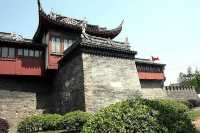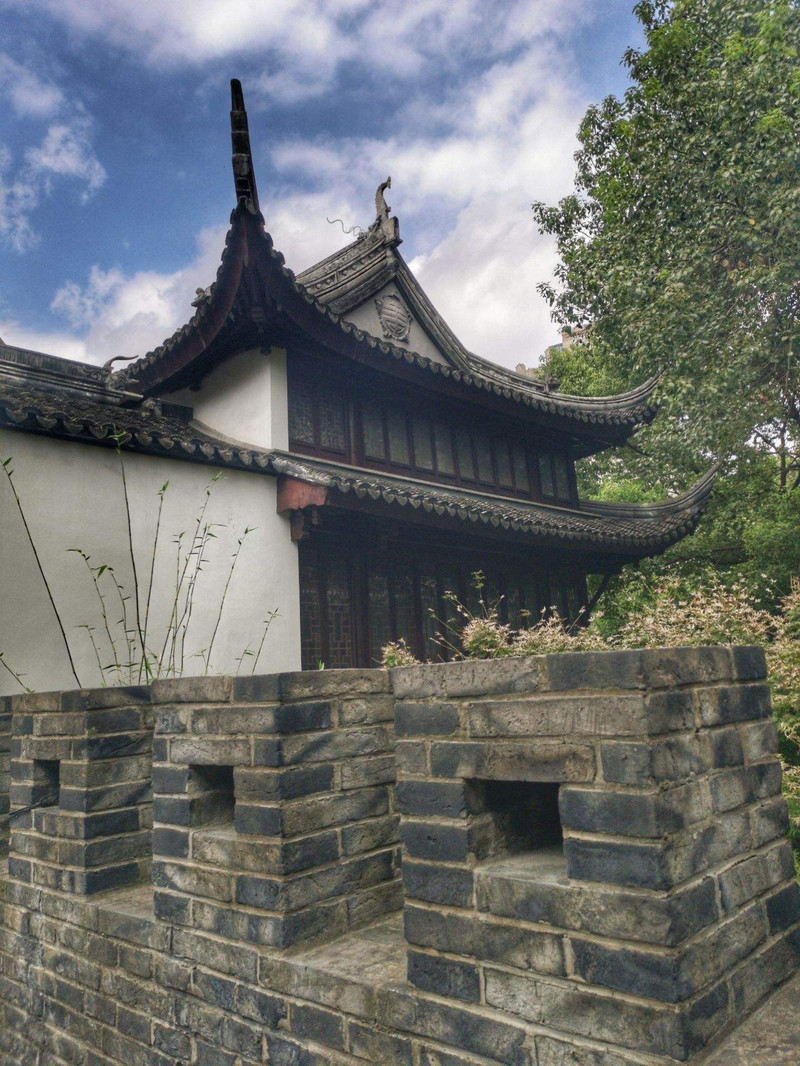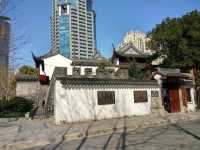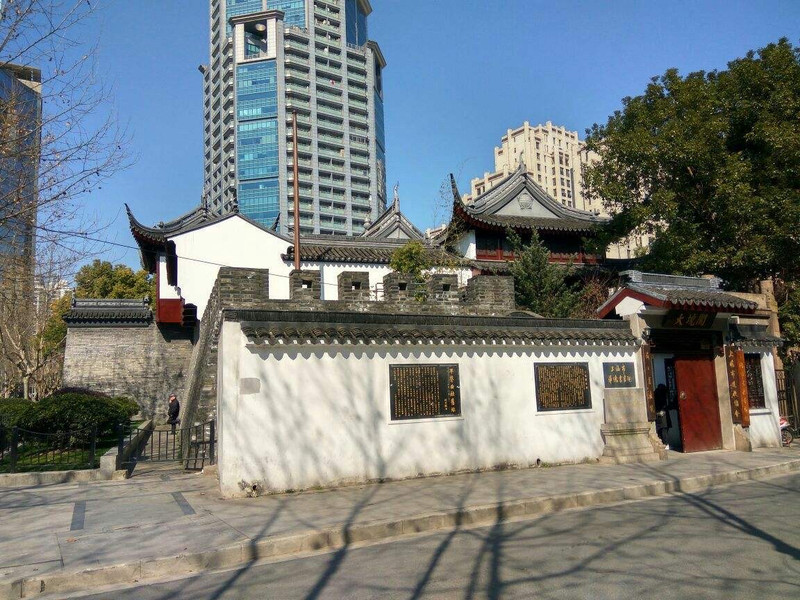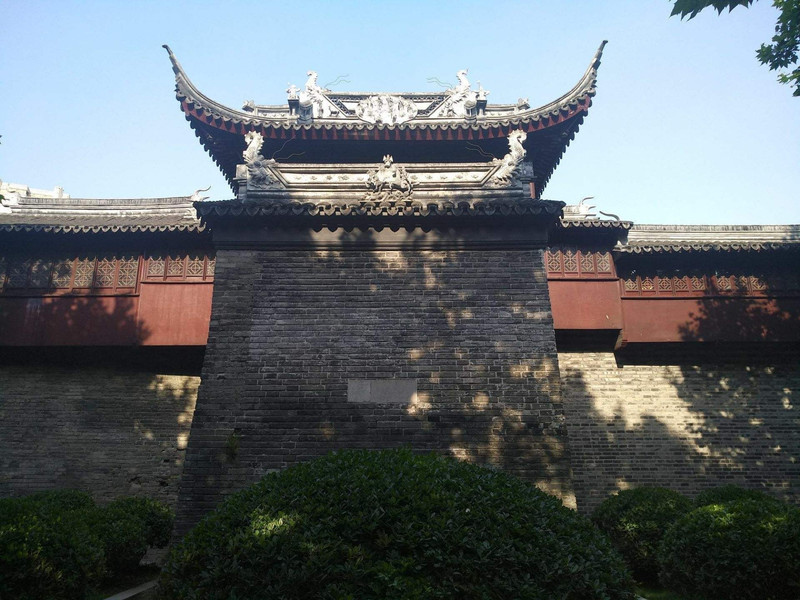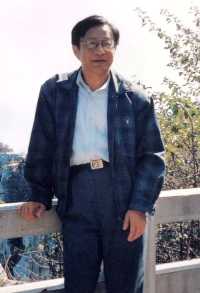There is a scenic spot at the intersection of Renmin Road in the old city of Shanghai. This is a section of the ancient city wall that is nearly 50 meters long and the Dajing Pavilion built on the ancient city wall. Shanghai has not built a city wall since the Yuan Dynasty, and was repeatedly invaded by the emperor during the Ming Dynasty. Therefore, in the 32nd year of Ming Jiajing (1553), it took only 3 months to build a city wall of 9 Huali, high 2.4 Zhang, more than 3,600 built on the city, 2 enemy buildings, along the city wall outside the building of 6 feet, deep 1.7 Zhang, Zhou Chang more than 1,500 Zhang. In the 36th year of Ming Jiajing (1557), he added 3 enemy buildings and 20 arrow platforms. During the Wanli period, the disaster calmed down and the county was peaceful. On the 4 arrow platforms, Danfeng Building, Guanyin Pavilion, Zhenwu Temple and Dajing Pavilion were built. Built on the archway of Dajing, the Pavilion is a three-story pavilion with exquisite structure and chic shape. This pavilion was built in the Ming Dynasty and was used for the statue of Guan Di, Qing Jiaqing 20 years (1815), and was converted into a three-story pavilion (that is, today's pavilion). In the first year of Daoguang (1821), Governor Tao Yandeng Pavilion after sightseeing, the title "Kuangguan" hung on the "Xichuntai", Daoguang 16 years (1836), Governor Chen Yu of the two rivers toured this, the title "Great Thousand Victory Land" four words inscribed on the East Shoushifang. So this pavilion is famous, listed as one of the eight scenic spots of the city "Jiangyan Snow", and has become one of the tourist hotspots in Shencheng. Since modern times, Dajing Pavilion has been a gathering place for literati and inks. From the late Qing Dynasty to the beginning of the People's Republic of China, the three-story building of this pavilion was a place of painting and meeting friends such as Wu Fuchan, Hua Molong, Ren Bonian, Zhu Yingzhan and other famous painters. In 1917, the famous Kunqu teacher Chen Fengming, Ding Lansheng, ticket friend Yu Yusheng, etc. on the second floor of the establishment of the "Pingsheng Qu Society", Kunqu artist Mo Shuzhai also opened Kunqu Learning Classes to train Kunqu Rookie. In 1952, the Kun drama "Peach Blossom Fan", directed by Ying Yunwei and starring Shi Xiangyun, was performed after the group in this pavilion. In the late Qing Dynasty, Shanghai's economy developed rapidly. People of knowledge in Shanghai realized that the ancient city building had become an obstacle to traffic in and outside the city and affecting economic development. So in July 1912, the southern half of the city was demolished, and the northern half of the city was demolished in 1913. Since the demolition of the city headquarters, the city road work office is located in the Dajing Pavilion, and some people request to retain the Dajing Pavilion, and then fill the earth of the Dajing Yours with nine acres of soil, so that this wall and the Dajing Pavilion can be retained. Starting in 1992, after three years of efforts, the people's government of Nancheng District moved 31 residents, 9 units, cost 9 million yuan, the ancient city wall and Dajing Pavilion will be restored and opened as before, for tourists to visit.
;
Old City Wall at Dajing Road (Dajing Ge) Review
4.6 /5232 Reviews
Popular Destinations
Chester Travel | Nanjing Travel | Northampton Travel | Hiroshima Travel | Belfast Travel | Sheffield Travel | Pakistan Travel | Chennai Travel | Krabi Travel | Nevsehir Travel | Los Angeles Travel | Dublin Travel | Nottingham Travel | Swansea Travel | Prague Travel | El Calafate Travel | Kefallinia Travel | Paralimni Travel | Yangcheng Lake Travel | Hobart Travel | Treviso Travel | Druskininkai Municipality Travel | Banska Bystrica District Travel | Margam Travel | Port Erin Travel | Clay County Travel | Aberdeenshire Travel | Coos Bay Travel | Subbetica Travel | Hanno Travel
Recommended Attractions at Popular Destinations
Bangkok attraction near me | Tokyo attraction near me | Manila attraction near me | Hong Kong attraction near me | Taipei attraction near me | Seoul attraction near me | Los Angeles attraction near me | New York attraction near me | Shanghai attraction near me | Kuala Lumpur attraction near me | Shenzhen attraction near me | Osaka attraction near me | Singapore attraction near me | Guangzhou attraction near me | London attraction near me | San Francisco attraction near me | Beijing attraction near me | Macau attraction near me | Bali attraction near me | Paris attraction near me | Ho Chi Minh City attraction near me | Orlando attraction near me | Jakarta attraction near me | Phuket attraction near me | Chicago attraction near me | Toronto attraction near me | Istanbul attraction near me | Cebu attraction near me | Dallas attraction near me | Seattle attraction near me
Popular Attractions
Colosseum | Ba Na Hills | Mount Huangshan | Zhujiajiao Ancient Town Scenic Area | Lingyin Temple | Keukenhof | Warner Bros. Studio Tour Tokyo - The Making of Harry Potter | Sunway Lost World of Tambun | Walt Disney World Resort | Canterbury Cathedral | Sagrada Familia | Casa Batlló | Mengalum Island | Royal Albert Dock Liverpool | Shichahai | Sun World Halong Complex | Playa de Sa Coma | Pantai Baling Karang | Dr. B.R Ambedkar Park | Masjid baiturrokhim | Garhi kanaura Ambedkar park | MASJID AL-AMIN | Berozovaya Roshcha | ISKCON Temple | Base de loisirs de l'Île Charlemagne | skate park | Victory Church Tuguegarao | Grand Bazaar | Tiger Kingdom - Phuket | Chengdu Research Base of Giant Panda Breeding
Popular Travelogues
Bangkok Travelogue | Tokyo Travelogue | Hong Kong Travelogue | Seoul Travelogue | Los Angeles Travelogue | New York Travelogue | Shanghai Travelogue | Kuala Lumpur Travelogue | Shenzhen Travelogue | Osaka Travelogue | Singapore Travelogue | Guangzhou Travelogue | London Travelogue | San Francisco Travelogue | Beijing Travelogue | Macau Travelogue | Bali Travelogue | Paris Travelogue | Ho Chi Minh City Travelogue | Phuket Travelogue | Chicago Travelogue | Toronto Travelogue
Payment Methods
Our Partners
Copyright © 2024 Trip.com Travel Singapore Pte. Ltd. All rights reserved
Site Operator: Trip.com Travel Singapore Pte. Ltd.
Site Operator: Trip.com Travel Singapore Pte. Ltd.
